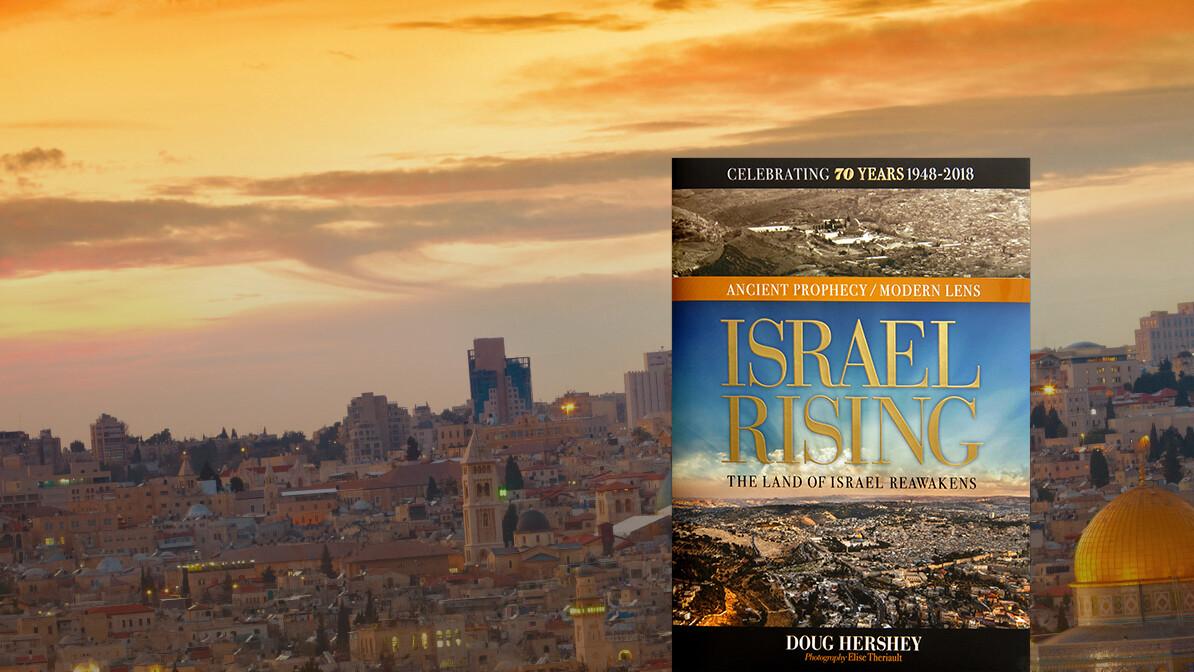- Home
- Spiritual Life
- Israel Rising: Bible Prophecy Comes to Life

Israel Rising: Bible Prophecy Comes to Life
Craig von Buseck: The ancient prophecy in Ezekiel chapter 36 is the theological basis for your book. How did this passage of Scripture come to life for you to draw you to Israel?
Doug Hershey: It’s one of those things where you can read a Scripture passage one or two times and it doesn’t really grab you until it’s the right season, or the right time in your life. That passage in Ezekiel never really grabbed me until I started traveling through Israel many years ago. I started noticing how the country was rapidly developing. As I drove through the countryside I recognized the new pastures, or buildings, or vineyards. So I just happen to be reading through Ezekiel chapter 36 again, and I thought, “wait a minute, I think this is what I’m seeing.”
So I started that whole process of biblical interpretation, recognizing that this prophecy was 2,600 years ago. I asked, has there ever been a time since Ezekiel’s prophecy that this could have been fulfilled. That started the whole journey. Is this the time and season these prophetic words come to pass? Are we really seeing the Bible coming to life here?
Ezekiel 36 was a chapter I had read before, but had never thought much of it. Then when I saw the rapid development of the land, I thought, “I’ve seen something like this before.”
Truth in the Photographs
CVB: So, how did you come to the concept of the comparative photographs? That is a very interesting idea.
Doug: In the old city of Jerusalem, in pretty much any gift shop, you see these old black-and-white postcards of famous spots around the holy city. Again it was just one of those things where as I’m kind of pondering the land. I was in the old city of Jerusalem, just wandering through. I’ve always had a love for these old black-and-white photos because a lot of them are from barely 100 years ago, but it looks like a completely different world.
CVB: In reality they are a time capsule, because it was that way for hundreds, if not thousands of years before that.
Doug: Exactly. So probably one of the most stunning thoughts was, “I wonder how we can capture some of this?” I have some old photos in front of the Damascus gate where there are camel caravans and people who look like they were in Lawrence of Arabia. And I thought, “I just walked through that gate a few hours ago, and it looks nothing like that.” I began looking at the time frames and realized these photos were from the 1920s — this wasn’t even 100 years ago.
I began wanting to capture that stark difference between the two. I have a travel company called Ezra Adventures and I am constantly trying to introduce people to the real Israel. I want to show what’s really happening in the land, as opposed to the typical tourist view. We take small groups not only to famous biblical sites, but also to what’s really happening in the land right now. As you said, this land was desolate for hundreds of years, until 70 years ago, and now there are these dramatic changes. Why do you think we are seeing this transformation?
I want to be able to capture it for myself, because I think those comparisons are fascinating. But I also wanted it to be something that I could communicate to others. If there is someone who was never been to Israel, it wouldn’t be just another photo book, but it would be a way of documenting what is happening in the land right now.
New Life in the Trees
CVB: It was so powerful going through the photos. The thing that jumped out to me where the trees — the lack of trees before, and now the trees that are there. You show Jaffa, Tel Aviv, Haifa, and other places with the old cars, and there were either no trees, or the trees are just been planted. Then you show today where the trees are huge, and full, and giving shade. Tell a little bit about your feeling with regard to the trees in the Holy Land.
Doug: When we are driving through Israel I will say to my tour group, “look out the window and find a tree that has a large root system.” So people will be looking and looking, but inevitably they can’t find them because many of the trees are only 60 or 70 years old. Part of the reason is that the Ottomans from 1517 to 1917 had this crazy taxation policy where they taxed the people of the region based on the number of trees they had on their land.
CVB: Oh my goodness.
Doug: And so what do you do if you don’t want to pay taxes? You cut down your trees. This completely decimated the entire region. Topsoil is blown away. Erosion takes over. These ancient irrigation ditches from 1000 years before begin to just completely fall apart. Weather patterns change. Animal populations just disappear as they move out of the region. Most historians agree, that the 400 to 500 years prior to Israel being reestablished in 1948 was probably some of the most desolate, empty, destructive times for the physical land.
Up in the Haifa region, in the Mount Caramel mountain range, there are huge forests up there, but 100 years ago that was completely barren. The Jewish national fund records planting more than 250 million trees in the last 100 years.
CVB: That is awesome!
Doug: And what’s amazing about that to me is that all of those were planted by hand. So one of my favorite photos in the book regarding trees, if you turn to the page featuring Ein Herod, you will see a kibbutz in the Jezreel Valley near Mt. Gilboa — where Saul and Jonathan died at the hands of the Philistines. I went there with the photographer thinking I wanted to see how much the trees had grown. If you look at the old photo on the left, that range is completely empty. Then when you look at the new photo on the right, you see that the trees were not only planted, but they were arranged with some order. Somebody climbed those mountains and planted those trees by hand — they didn’t just appear out of nowhere.
When you begin planting trees on mountains, that changes the weather patterns and it changes the amount of moisture in the air. Topsoil is re-created by leaves falling and animal population coming back into the area. It all comes back to life.
There’s a place called Nimrod’s Fortress, which is actually an old crusader castle. If you compare photos, the archaeology hasn’t changed. What is stunning is that the black and white photo looks like there was just some shrub brush, while the new photo is completely green. If you look into the upper edge of the new photo, you see what looks like a barren patch of land. That land is Syria, it’s not Israel.
CVB: That’s very interesting.
Doug: So while the land is physically responding to Israeli sovereignty, the land just across the border with the same soil in the same amount of sunlight and rainfall — the only difference is a fence, the covenants, and the promise.
Redeeming the Environment
CVB: I have three Millennial children, and they hear so much negative news about Israel. But I’ve encouraged them to go and see what Israel has done to reclaim the desert. It is one of the most dramatic pro-environmental stories in the world. And so few people are talking about it. It’s great to read that message in your book.
Doug: You’re absolutely right, and what is stunning is that Israel right now is the only nation on earth where the deserts are shrinking and not expanding. So if you’re talking about environmentalism, physical restoration, planting food, Israel is leading the way.
In Ezekiel 36, there are two different places toward the end of the chapter where God is talking to the land, and he says you will no longer bear the reproach of famine among the nations. So today, with Israel’s desalinization plants taking seawater and turning it into fresh drinking water, along with the irrigation drip technology invented as part of their desert farming techniques in the last 40 years, we are seeing the deserts shrinking in Israel.
In addition, with Israel’s water reclamation plants, almost 90% of all of the wastewater that comes out of Israel’s population usage gets piped to cleaning facilities that will then treat it for agricultural purposes. So the desalinization plants are currently providing 40% of Israel’s water usage. They are expecting that by 2050, that number will be over 70%.
CVB: Wow. That’s amazing.
Doug: They are far ahead of what any other nation is doing on earth when it comes to desalinization. So quite literally, with the technology that Israel is developing, they are quickly becoming the first potentially drought proof nation on earth. So if it never rains again in Israel, they are pulling drinking water out of the sea, and their wastewater is being turned into agricultural water for their vegetables and fruit.
CVB: As the covenant promise to Abraham, Isaac, and Jacob says, “through you and your seed, all the nations of the earth shall be blessed” (Genesis 28:14).
Doug: Exactly, and you bring up an excellent point regarding the environmental aspect of all this. They are doing what no other nation has done on earth. And they are willingly sharing their technology.
…
Order your copy of Israel Rising: Ancient Prophecy, Modern Lens by Doug Hershey
Trending Now
Sign up today for your Inspiration Today Daily Newsletter
Supercharge your faith and ignite your spirit. Find hope in God’s word. Receive your Inspiration Today newsletter now!
Dr. Craig von Buseck
Dr. Craig von Buseck is an award-winning author, speaker, and Christian ministry leader known for his engaging storytelling and biblically grounded insights. His books, teachings, and inspirational messages encourage believers to trust God's guidance, walk in faith, and recognize His hand in everyday life.
Craig's writing blends historical research, spiritual wisdom, and practical application, making his work meaningful to readers across the Christian community.
Learn more about his books, teachings, and ministry at vonbuseck.com.
Related Articles
January 8, 2026
The Amazing Benefits of Living from the Inside Out
In “The Amazing Benefits of Living from the Inside Out,” Joyce Meyer teaches how transforming your…
January 6, 2026
Renew Your Mind: Replacing Lies with God’s Truth
What you believe shapes how you live—and many of us are living according to lies we’ve unknowingly…
January 5, 2026
More Than a Midnight Moment: What the New Year Reveals About the Human Heart
As the calendar turns, many of us feel a quiet ache for change that goes deeper than resolutions.…
January 5, 2026
Moving Your Heart in God’s Direction
Your spiritual heart influences every choice you make—your motives, your relationships, and the…
Next Steps To Strengthen Your Walk
Inspiration Today Newsletter
Supercharge your faith and ignite your spirit. Find hope in God’s word. Receive your Inspiration Today newsletter now!
Christian Articles
Find articles to strengthen your walk and grow your faith. We have a wide range of topics and authors for you.
Submit A Prayer Request
We are here for you. Simply click on the button below to reach us by form, email or phone. Together we will lift our hearts and voices with you in prayer.





